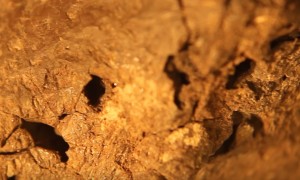Scientists who were dreaming of one day finding fossilized dinosaur brain tissue recently got their wish, but they couldn’t have imagined it would be “pickled.” This is what happened, according to a new report published in The Geological Society of London, and researchers are still marveling at their discovery.
“The chances of preserving brain tissue are incredibly small, so the discovery of this specimen is astonishing,” said co-author Dr. Alex Liu.
So what exactly happened to the dinosaur that once had the brain?
 The scientists believe that the brain may have become “pickled” in an extremely acidic and low-oxygen body of water, like a swamp. The dinosaur could have fallen into one of these bodies of water and died, allowing its brain tissue to become mineralized.
The scientists believe that the brain may have become “pickled” in an extremely acidic and low-oxygen body of water, like a swamp. The dinosaur could have fallen into one of these bodies of water and died, allowing its brain tissue to become mineralized.
“Since the water had little oxygen and was very acidic, the soft tissues of the brain were likely preserved and cast before the rest of its body was buried in the sediment,” said Dr. David Norman from the University of Cambridge, who coordinated the research.
The tissue that was recovered appeared to have been pressed directly against the skull. This led scientists to consider the fact that dinosaurs may have had large brains that occupied most of their cranial cavities (though many argued that this particular dinosaur had simply fallen on its side, causing the brain to slide up against the skull).
“As we can’t see the lobes of the brain itself, we can’t say for sure how big this dinosaur’s brain was,” Norman continued. “Of course, it’s entirely possible that dinosaurs had bigger brains than we give them credit for, but we can’t tell from this specimen alone. What’s truly remarkable is that conditions were just right in order to allow preservation of the brain tissue – hopefully this is the first of many such discoveries.”
The dinosaur itself was likely to be similar to a species known as Iguanodon, a large herbivorous dinosaur. It lived about 133 million years ago during the Early Cretaceous Period.
The findings were published in tribute to the late Martin Brasier of the University of Oxford. Along with Norman, Brasier coordinated research into the fossil where the brain tissue was found.
Sources
Brasier, Martin. Norman, David. Liu, Alexander. Cotton, Laura. Hiscocks, Jamie. Garwood, Russell. Antcliffe, Jonathan. Wacey, David. “Remarkable preservation of brain tissues in an Early Cretaceous iguanodontian dinosaur.” The Geological Society of London. Published Oct. 27, 2016.
Collins, Sarah. “Fossilised dinosaur brain tissue identified for the first time.” University of Cambridge. Published Oct. 27, 2016.
